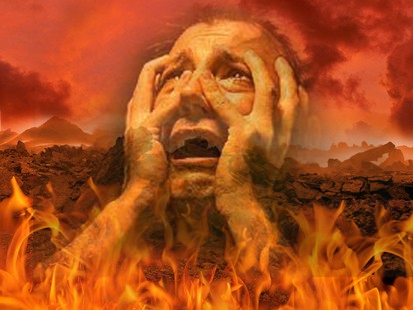An amazing feature of near-death experiences is that they are much the same no matter the religion or culture.
In one study of 1,000 cases in India and America, researchers found that when Indians were close to death, they told of encountering messengers and religious figures, much the same as Americans report. One difference: residents of India did not report seeing deceased loved ones as much as did Americans.
Another difference: in places such as Thailand,those who crossed over to the other side did not experience eternity as quite as pleasant as have Westerners. In Buddhism, the person who has such an experience is called a "delog."
 "There were both similarities and differences between Western and Thai near-death experiences," says a nurse named Dr. Penny Santori in a book called The Wisdom of Near-Death Experiences. "The tunnel was absent in Thai near-death experiences, as were feelings of bliss and ecstasy. Thai near-death experiences were mainly distressing in nature and depicted scenes of hell and torture. The dying person was forced to observe the tortures but did not experience them. There was only one case of an encounter with Heaven [in ten studied]."
"There were both similarities and differences between Western and Thai near-death experiences," says a nurse named Dr. Penny Santori in a book called The Wisdom of Near-Death Experiences. "The tunnel was absent in Thai near-death experiences, as were feelings of bliss and ecstasy. Thai near-death experiences were mainly distressing in nature and depicted scenes of hell and torture. The dying person was forced to observe the tortures but did not experience them. There was only one case of an encounter with Heaven [in ten studied]."
Of course, the main religious difference, between the two, by and large, is that Americans are predominately Christian; Thailand is chiefly Buddhist (not to besmirch Buddhism, but to report on the result of one study).
Some of it comes down to what is expected: The afterlife is presented initially in a way that the person in transition understands. This may account for why those in Eastern or Muslim countries sometimes report a meeting with famous Buddhist, Hindu, or Islamic figures.
In Tibet -- also largely Buddhist -- it is common for those who "die" to report that they were "taken to the Lord of Death and guided through hell, where they witness the torture of other sinful people. These people ask the person to convey messages to their families, asking them to perform rituals to absolve their suffering and urge others to live in a moralistic way." This sounds a bit like praying for the deceased in purgatory.
Another author, Nancy Bush, whose equally and perhaps even more fascinating book, Dancing Past the Dark, Distressing Near-Death Experiences, notes that, "One delog account from the 17th-century included descriptions of terrifying divinities of yellow, red, and green, a bridge over an ocean of fire, and tied-up victims being beaten for having eaten meat. Then she was taken to meet Yama, the terrible Lord of Death.
“Protected by her personal divinity, she entered his palace and trembled as she saw his ugly, red face, wide-eyed and fanged. Wearing a tiger skin, skulls, and flames, he held the fateful mirror of existence, a sword, and water. His frightening voice rumbled like a thousand dragons.
"He was attended by numerous ugly, animal-headed acolytes and a nasty, little, black demon holding black pebbles signifying the sinful deeds of each poor person to be judged. But a white deity held white pebbles that would weigh against the black deeds. This vast army of beasts was chanting 'execute! execute!' or whacking off the heads of the weeping victims.
 “In typical accounts of delogs, as young persons they have been gravely ill and seem to be dead to those grieving around them. But instead, they later report, they had risen up above their bodies, which then they did not recognize as their own. Next these persons’ dazed souls enter into a raucous hereafter, guided by their personal deity. They are taken to meet the horrifying Lord of Death himself.
“In typical accounts of delogs, as young persons they have been gravely ill and seem to be dead to those grieving around them. But instead, they later report, they had risen up above their bodies, which then they did not recognize as their own. Next these persons’ dazed souls enter into a raucous hereafter, guided by their personal deity. They are taken to meet the horrifying Lord of Death himself.
"They are led on a shocking tour of Hell, where they see numerous condemned souls miserably suffering punishments befitting their sins, such as the [Buddhist] nun who hears the unending cries of her own baby whom she murdered. The anguished sinners send urgent messages back to the living, begging family to do rituals to aid in their salvation and exhorting others to live an ethical life. The astonished travelers meet deceased parents and travel to paradise.
"Returning to the throne of the Lord of Death, they observe the dreadful judgment of souls with a bridge, a scale, or a mirror. They themselves are judged and given a message to send back. Their consciousnesses return to their bodies on earth. They deliver the various messages and exhort all to practice their Tibetan Buddhist religion faithfully."
Makes you think!
 In China, a survey of 120 deathbed visions showed -- again -- similarities and differences.
In China, a survey of 120 deathbed visions showed -- again -- similarities and differences.
In one account a Buddhist monk had a pleasant encounter whereby Buddha placed him in the palm of his hand and the light spread throughout the universe. Most interesting: a century ago a Confucian scholar who'd had just two lessons on the Christian faith "reported walking with Jesus to gates of pearl which were opened by angels that let them in," writes Santori. "She saw beautifully colored houses and walked with Jesus along golden streets. She saw thousands of angels encircling a throne on which the heavenly Father sat and He told her that she may go back for a while but must return on the twelfth of the month. A few days passed and on the twelfth of the month she dressed in her funeral clothes, lay down on the bed, and died." When Jesus is missing, it is precarious (to use understatement).
In Japan, many accounts include the upside of a temple gate and pleasant feelings; beautiful flowers are a prominent feature.
Some are sent back by relatives, as in so many Western accounts.
 One researcher who interviewed seventeen patients found that nine had no memories, but eight who "died and returned" recalled rivers or ponds; of those eight, five were unpleasant. In one case a man who had been pronounced dead and sent to the mortuary, where he later came to, described a journey to his new house that was still in the process of construction. His account is similar to the one in China.
One researcher who interviewed seventeen patients found that nine had no memories, but eight who "died and returned" recalled rivers or ponds; of those eight, five were unpleasant. In one case a man who had been pronounced dead and sent to the mortuary, where he later came to, described a journey to his new house that was still in the process of construction. His account is similar to the one in China.
"He was told to go back and that it would be ready for him in a month's time," writes Bush.
"He died a month after he had revived."



1 comment:
Purgatory is one of the most neglected topics of catechesis since VCII. The Church has implied, suggested and taught that for the most part most souls go directly to Heaven. This has done great harm in distorting God's mercy with His justice.
JMJ,
George Brenner
Post a Comment